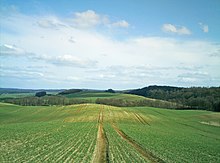Am Stettiner Haff Nature Park

The Am Stettiner Haff Nature Park is one of seven nature parks in Mecklenburg-Western Pomerania .
geography
The nature park is located south of the eponymous Szczecin Lagoon on the border with Poland . It stretches from the lagoon coast to the Brohmer Mountains in the south. The landscape is characterized by the lagoon coast, flat and hilly terminal moraine landscape , beech and mixed forests, lean sandy soils and the fen areas along the rivers. Larger natural areas are the Ueckermünder Heide , the Brohmer Mountains, the Randowbruch and the Friedländer Große Wiese .
To the west is the Galenbeck lake , which is not part of the nature park itself. The rivers Randow , Uecker , Zarow and Großer Landgraben flow or arise in the nature park. Large parts of the Ueckermünder Heide south of Eggesin are restricted areas as military training areas and do not belong to the nature park. The city of Pasewalk is centrally located between the two arms of the nature park that reach south. The Baltic Sea motorway A 20 runs south and west of the nature park .
Together with the Sternberger Seenland nature park, the nature park is one of the youngest nature parks in Mecklenburg-Western Pomerania and was founded on January 1, 2005. When it was founded, it covered a total area of 53,793 hectares. About 8% of the total area of the park were nature reserves and 51% were designated landscape protection areas. The representative seat of the nature park administration with the visitor information center has been in Eggesin since August 18, 2012. On October 22, 2018, the communities of Blankensee and Plöwen were completely integrated into the nature park, so that its area increased by around 1,600 hectares. Since then, the proportion of nature conservation and landscape protection areas has been 57.6%.
The southwestern part of the nature park overlaps with the Geopark Mecklenburg Ice Age Landscape , which forms the geological transition to the Feldberger Seenlandschaft Nature Park .
Landscape development

The landscape was shaped by the Pomeranian stage of the Vistula Ice Age around 12,000 to 10,000 years ago. The resulting low-relief surface structures of the ground moraine are characterized by layers of ice, oser , valleys and basins. One of the most conspicuous ice edge locations is the Rosenthaler edge location with dam walls and individual sand deposits ( Brohmer Mountains ) near Jatznick.
The Haffstausee was created in the late glacial and was fed with melt water from the glacial valleys via the Oder, Ina, Uecker and Randow valleys. With the increasing retreat of the inland ice to the north, the water level of the Haff reservoir fell in stages. The terraces on the edge of the reservoir are evidence of this.
The deepest areas of the Haff reservoir were subject to silting processes , beginning in the late glacial and intensified in the Holocene , which later resulted in basin clays and sands being deposited in the basin formation. Due to the movement of wind , drifting sand covers and inland dunes were deposited, which shape the characteristic image of the Ueckermünder Heide today.
In the warm period of the Holocene, small lakes were created in the hinterland of the Szczecin Lagoon. In the lowlands of the river valleys there was bog with muds, lake chalk and fens .
Humans as a geological factor have influenced this development for 5000 years.
animals and plants
flora
Due to the different water supply of the soils, a wide range of species has developed. In addition to near-natural mixed forests of beech and oak, coniferous forests form the main forest in the region. In the damp or wet locations, broken forest communities have developed. Marsh marigolds and orchids are characteristic of these areas .
fauna
The otter can often be found in the rivers Uecker , Randow and Zarow . Many rare bird species are at home here, such as white-tailed eagles , lesser spotted eagles , black storks and bitterns . You can also see cranes here. The extremely rare hoopoe has also recaptured the restricted areas of the military training areas. Painted ladies and other large butterflies can also be found here.
Protected areas


Nature reserves
There are ten nature reserves in the nature park with a total area of 7074 hectares. This corresponds to 13 percent of the nature park area.
- Ahlbecker Seegrund (1280 ha)
- Altwarper Binnendunen, Neuwarper See and Riether Werder (1433 ha)
- Rothemühl castle wall (46 ha)
- Galenbeck Lake (1900 ha)
- Gorin Lake (249 ha)
- Gottesheide with Schlosssee and Lenzensee (1405 ha)
- Kleppelshagen (304 ha)
- Plöwensches Seebruch (229 ha)
- Wild moor near Borken (228 ha)
Landscape protection areas
- Lagoon coast (26,000 ha)
- Brohmer Mountains (1,892 ha)
- Löcknitzer See
- Pasewalker Kirchenforst (790 ha)
- Pomeranian Bodden Coast (glassworks)
- Rosenthaler relay
- Radewitz Heath
Natural monuments
There are 65 natural monuments in the entire nature park, including many common oaks and linden trees, but also pines and beeches.
It also includes, among other things, small meadows and moors.
See also
literature
- State Office for the Environment, Nature Conservation and Geology and the Uecker-Randow District (ed.): Nature Park Plan "Am Stettiner Haff". Volume 1 - Mission statement, goals and implementation strategies. Volume 2 - data and facts. Volume 3 - Project overview. Guestrow 2008
Web links
- State ordinance establishing the nature park "Am Stettiner Haff" of December 20, 2004, last amended on July 3, 2008
- Homepage of the nature park with event calendar etc.
- Leaflet of the nature park with presentation of the nature reserves (PDF) (9.2 MB)
- Presentation of the friends' association
Individual evidence
- ↑ Ministry of Agriculture and Environment Mecklenburg-Western Pomerania: Am Stettiner Haff Nature Park expanded - Profit for rural areas from November 29, 2018, accessed on July 16, 2019





